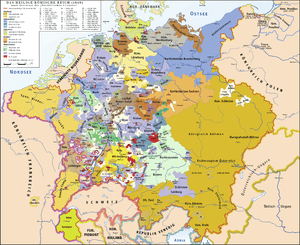Electorate of Saxony
The Electorate of Saxony (German: Kurfürstentum Sachsen, also Kursachsen) was a state of the Holy Roman Empire established when Emperor Charles IV raised the Ascanian duchy of Saxe-Wittenberg to the status of an Electorate by the Golden Bull of 1356.[3] Upon the extinction of the House of Ascania, it was feoffed to the Margraves of Meissen from the Wettin dynasty in 1423, who moved the ducal residence up the river Elbe to Dresden. After the Empire's dissolution in 1806, the Wettin Electors raised Saxony to a territorially reduced kingdom.[4]
Electorate of Saxony | |||||||||||
|---|---|---|---|---|---|---|---|---|---|---|---|
| 1356–1806 | |||||||||||
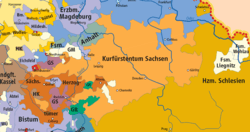
| |||||||||||
| Status | State of the Holy Roman Empire Imperial elector Personal union with Polish–Lithuanian Commonwealth (1697–1706 and 1709–1763) | ||||||||||
| Capital |
| ||||||||||
| Religion | Dominant confession among the population was Roman Catholic (until 1520s) and Lutheran (from 1520s). Elector was Roman Catholic until 1525, then Lutheran until 1697, then again Roman Catholic since 1697. | ||||||||||
| Government | Feudal monarchy | ||||||||||
| Prince-Elector | |||||||||||
• 1356 | Rudolph I (first) | ||||||||||
• 1419–1422 | Albert III (last Ascanian) | ||||||||||
• 1423–1428 | Frederick I (first Wettin) | ||||||||||
• 1763–1806 | Frederick Augustus III (last) | ||||||||||
| Historical era | Early modern Europe | ||||||||||
| 10 January 1356 | |||||||||||
| 6 January 1423 | |||||||||||
| 26 August 1485 | |||||||||||
| 19 May 1547 | |||||||||||
| 15 June 1635 | |||||||||||
| 1697–1706 & 1709–63 | |||||||||||
• Raised to kingdom | 20 December 1806 | ||||||||||
| |||||||||||
| Today part of | |||||||||||
Formation and Ascanian rule
After the dissolution of the medieval Duchy of Saxony, the name Saxony was first applied to a small territory midway along the river Elbe, around the city of Wittenberg, which had formerly belonged to the March of Lusatia. Around 1157 it was held by Albert the Bear, the first Margrave of Brandenburg. When Emperor Frederick Barbarossa deposed the Saxon duke, Henry the Lion in 1180, the Wittenberg lands belonged to Albert's youngest son, Count Bernhard of Anhalt, who assumed the Saxon ducal title. Bernard's eldest son, Albert I, ceded the territory known as Anhalt to his younger brother, Henry, retaining the ducal title and attached to this territory the lordship of Lauenburg. His sons divided the territory into the duchies of Saxe-Wittenberg and Saxe-Lauenburg. Both lines claimed the Saxon electoral dignity or privilege, which led to confusion during the 1314 election of the Wittelsbach duke, Louis of Bavaria as King of the Romans against his Habsburg rival, Duke Frederick the Fair of Austria, as both candidates received one vote each from each of the two rival Ascanian branches.
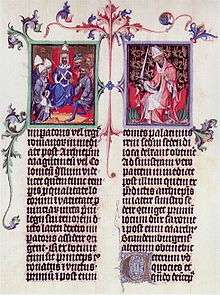
Louis was succeeded by the Luxembourg king, Charles of Bohemia. After his coronation as Holy Roman Emperor in 1355, Charles issued the Golden Bull of 1356, the fundamental law of the Empire settling the method of electing the German King by seven Prince-electors. The rival Wittelsbach and Habsburg dynasties got nothing, instead the Duke of Saxe-Wittenberg, Archmarshal of the Empire, received the right to elect the King of the Romans and the prospective Emperor, together with six other elector Princes of the Empire. Thus, the country, though small in area, gained influence far beyond its extent.[4]
The electoral privilege also contained the obligation of male primogeniture. That is, only the eldest son could succeed as ruler. It therefore forbade the division of the territory among several heirs, in order to prevent the disintegration of the country. The importance of this stipulation is shown by the history of most of the fragmented German principalities (e.g. the Saxon Duchy of Brunswick-Lüneburg) which were not constituted as electorates.[4]
Wettin rule
_-_DE.png)
The Ascanian line of Saxe-Wittenberg became extinct with the death of Elector Albert III in 1422, after which Emperor Sigismund granted the country and electoral privilege upon Margrave Frederick IV of Meissen, who had been a loyal supporter in the Hussite Wars. The late Albert's Ascanian relative, Duke Eric V of Saxe-Lauenburg protested in vain. Frederick, one of the seven Prince-electors, was a member of the House of Wettin, which since 1089 had ruled over the adjacent Margravate of Meissen up the Elbe river - established under Emperor Otto I in 965 - and also over the Landgravate of Thuringia since 1242. Thus, in 1423, Saxe-Wittenberg, the Margravate of Meissen and Thuringia were united under one ruler, and as a unified territory gradually became known as, Upper Saxony.[5]
When Elector Frederick II died in 1464, his two surviving sons overrode the primogeniture principle and divided his territories by the Treaty of Leipzig on 26 August 1485. This resulted in the already separated Wettin dynasty becoming the Ernestine and Albertine branches. The elder Ernest, founder of the Ernestine line, received large parts of the former Duchy of Saxe-Wittenberg with the electoral privilege attached to it, and the southern Landgravate of Thuringia. While the younger Albert, founder of the Albertine line, received northern Thuringia and the lands of the former Margravate of Meissen. Thus, although the Ernestine line had initially had greater authority until the Battle of Mühlberg in 1547, the electoral privilege and territory then fell to the Albertine line, which later also became a royal house when Saxony was proclaimed a kingdom in the 19th century. This partition was to decisively enfeeble the Wettin dynasty in relation to the then rising House of Hohenzollern. It had already achieved its own electoral privilege as Margraves of Brandenburg since 1415.[4]
Protestant Reformation

The Protestant movement of the 16th century largely spread under the protection of the Saxon rulers. Ernest's son, Elector Frederick the Wise established in 1502 the University at Wittenberg, where the Augustinian monk, Martin Luther, was appointed professor of philosophy in 1508. At the same time he became one of the preachers at the castle church in Wittenberg. On 31 October 1517, he enclosed in a protest letter to Albert of Brandenburg the Archbishop of Mainz, The Ninety-five Theses against the sale of indulgences and other Catholic practices, an action that marked the start of what came to be called the Reformation. Although the Elector did not at first share the new attitude, he granted his protection to Luther anyway. Owing to this intervention, Pope Leo X decided against summoning Luther to Rome in 1518, and the Elector secured for Luther Imperial safe-conduct to the Diet of Worms in 1521. When Luther was declared banned in the entire empire by Emperor Charles V, the Elector had him brought to live in Wartburg Castle on his Thuringian estate. Lutheran doctrines spread first in Ernestine Saxony.[4]
In 1525, Frederick died, possibly never having officially left the Catholic Church, unless on his deathbed in 1525, but he was sympathetic towards Lutheranism by the time of his death.[6] He was succeeded by his brother, John the Constant. John was already a zealous Lutheran. He exercised full authority over the new church introduced as, the "Lutheran Confession", and ordered the dismissal of all priests who continued in the Catholic faith. He directed the use of the Vernacular Liturgy drawn up by Luther. In 1531 he formed the Schmalkaldic League with a number of other ruling princes for the continuation of the Protestant doctrine and for a joint defence against the Habsburg Emperor Charles V, a fierce opponent of the Reformation. John was followed in 1532 by his son, John Frederick the Magnanimous (died 1554), who was also one of the leaders of the Schmalkaldic League. In 1542, he seized the Diocese of Naumburg-Zeitz, and confiscated the secular possessions of the Dioceses of Meissen and Hildesheim. Lutheranism, as it came to be organised in Saxony, would serve as an example for future Protestant states throughout Europe.[4][7]
The Electorate of Saxony was, however, not the first state to establish Lutheranism as the state religion. Other states, like the Duchy of Prussia (1525) and the Landgraviate of Hesse (1526), preceded the official establishment of it in Saxony (1527).
Schmalkaldic War
_-_NL.png)
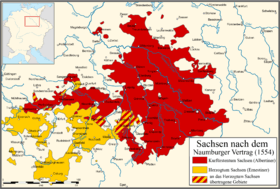

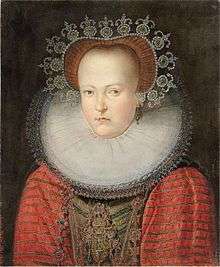
Meanwhile, in the Albertine lands Duke Albert's son, George (1500–39), founder of the Catholic League of Dessau, was a strong opponent of the Lutheran doctrine and had repeatedly sought to influence his Ernestine cousins in favour of the Catholic Church. However, George's brother and successor, Duke Henry IV of Saxony (1539–41), was finally won over to Protestantism under the influence of his wife, Catherine of Mecklenburg, and thus the Catholic diocese of Meissen came to be abolished. Henry's son and successor, Duke Maurice, was one of the most controversial figures of the Reformation period. Although a zealous Protestant, ambition and desire to increase his wealth led him to join the Emperor against the Schmalkaldic League, established by his Ernestine cousin, John Frederick.
After the outbreak of the Schmalkaldic War Elector John Frederick was placed under an Imperial ban and was finally defeated and captured by Emperor Charles V at the Battle of Mühlberg on 24 April 1547. The Capitulation of Wittenberg of May 19 obliged him to cede former Saxe-Wittenberg with its electoral privilege to his Albertine cousin, Duke Maurice, who had switched sides as fortunes reversed. After the Capitulation, the Ernestine branch of the Wettin family only retained its possessions in Thuringia, that owing to repeated divisions among the heirs from 1572 onwards, was soon cut up into the minor Ernestine duchies of Saxe-Weimar, Saxe-Coburg-Eisenach et al.[4] Those still in existence at the time of the 1918 German Revolution after World War I were the Grand Duchy of Saxe-Weimar-Eisenach and the duchies of Saxe-Coburg-Gotha, Saxe-Meiningen and Saxe-Altenburg.
After the Wittenberg Capitulation the Saxon Electorate consisted of former Saxe-Wittenberg and Meissen now united, and remained under the authority of the Albertine line of the Wettin family. Maurice again became estranged from Charles V partly out of resentment for not receiving what was left of the Ernestine possessions, but even more on account of his motivation to see a Protestant at the head of the empire. After the Emperor had issued the Augsburg Interim, Maurice concluded an alliance with King Henry II of France and through the Treaty of Chambord 1552 ceded the Three Bishoprics of Metz, Toul, and Verdun in Lorraine to France. Maurice secretly took part in all the princely conspiracies against the Emperor, who only escaped capture by fleeing. During the same year, Charles V was obliged by the Peace of Passau to grant freedom of religion to the Protestant states.[4]
Maurice died in 1553 at the age of 32. His brother and successor, Elector Augustus, seized the Catholic dioceses of Merseburg and Naumburg-Zeitz for himself. The last Bishop of Merseburg, Michael Helding called Sidonius, died at Vienna in 1561. The Emperor demanded the election of a new bishop, but Augustus forced the election of his son Alexander, who was eight years old, as administrator. After Alexander had died in 1565, he administered the diocese himself. Similarly, after the death in 1564 of Julius von Pflug, the last Catholic Bishop of Naumburg, the Elector confiscated the bishopric and forbade adherence to the Catholic religion. Those cathedral canons who were still Catholic were only permitted to practice their religion for ten more years. In 1581, John of Haugwitz, the last Bishop of Meissen, resigned his office. In 1587 he became a Protestant. The episcopal domains fell likewise to Saxony, and the cathedral chapter ceased to exist.[4]
During the reigns of the Elector Augustus (1553–86) and Christian (1586–91), a movement called Crypto-Calvinism gained strength in the electorate. As Christian II (1591–1611) was too young to rule, his mother, Sophie of Brandenburg became regent in 1591 and was the only woman to act as "Elector". She was vehemently opposed to the "new" movement. Just as her young son was assuming the reins of power in 1601, the Saxon chancellor, Nikolaus Krell, who had been spreading the other Protestant doctrine, was overthrown and beheaded in 1601.[8] A more strict adherence to Lutheranism was reintroduced and with it a religious oath.[4]
Thirty Years' War
.svg.png)
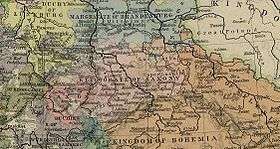
The Thirty Years' War (1618–48) occurred during the reign of Elector John George (1611–56). In this struggle, the Elector was at first neutral, and for a long time he would not listen to the overtures of King Gustavus Adolphus of Sweden. Not until the Imperial General Johann Tserclaes of Tilly advanced into Saxony did the Elector join the forces of the Swedish Empire. However, after the 1634 Battle of Nördlingen, the Elector concluded the Peace of Prague with Emperor Ferdinand II in 1635. By this treaty, Saxony received the Margravates of Upper and Lower Lusatia as a Bohemian fiefdom, and the condition of the Church lands that had been secularized was not altered. The Swedes, for their part, took revenge with ten years of plunder.[4]
By the 1648 Peace of Westphalia Saxony retained its Lusatian possessions as an Imperial fiefdom. However, it lost forever the possibility of extending its territory along the lower course of the Elbe into the lands of the Archbishopric of Magdeburg, even though they were under the administration of the Wettin Duke, Augustus of Saxe-Weissenfels. Upon his death in 1680, the secularised Duchy of Magdeburg fell to the "Great Elector" Frederick William of Brandenburg, which confirmed the primacy of Brandenburg-Prussia under the Protestant Hohenzollern dynasty. In 1653, the Saxon elector became the head of the Corpus Evangelicorum, the union of the Protestant Imperial Estates. Under the following Electors, religious questions were not as prominent. A rigid Lutheranism remained the prevailing faith, and the practice of any other faith was strictly prohibited. About the middle of the 17th century, Italian merchants were the first Catholics to reappear in the country. They settled in Dresden, the capital, and in Leipzig, the most important commercial city. The practice of Roman Catholicism was, however, not permitted to them.[4]
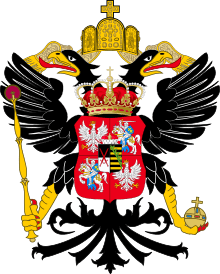
Saxony-Commonwealth of Poland-Lithuania
On 1 June 1697, Elector Frederick Augustus I, "the Strong" (1694–1733) converted to Catholicism and was subsequently elected King of Poland and Grand duke of Lithuania. This marked a personal union between Saxony and the Commonwealth of Two Nations that lasted almost 70 years with interruptions (see Stanislaw Leszczynski).[9][10] Meanwhile, in Saxony the formation of a Catholic parish and private observance of the Catholic faith was permitted at least in Dresden. The conversion of the Elector raised fears among many Lutherans that Catholicism would now be re-established in Saxony. In response, the Elector transferred his authority over Lutheran institutions (which, until then, had been exercised by the sovereign) to a government board, the Privy Council. The Privy Council was composed exclusively of Protestants. Even after his conversion, the Elector remained the head of the Protestant body in the Reichstag, despite an unsuccessful attempt by Brandenburg-Prussia and Hanover to take over the position in 1717–1720.[4]

His son, Elector Frederick Augustus II (1733–63), was received into the Catholic Church, while still heir-apparent, on 28 November 1712, in Bologna, Italy. With this conversion, which on account of the excitable sentiment of the Lutheran population, had to be kept secret for five years, the ruling family of Saxony once more became Catholic. He too was controversially "elected King of Poland and Grand duke of Lithuania", that is monarch of the Commonwealth of Poland-Lithuania against the French candidate, Louis François, Prince of Conti, who, on learning the result, attempted to claim the throne arriving by sea at the port of Gdańsk. His attempt was repulsed.[11] Frederick Augustus reigned as Augustus III of Poland 1734–1763.[12]
Saxony's partial return to Rome
Before this, individual members of the Albertine line had returned to the Roman Church, but they had died without issue, as did the last rulers of Saxe-Merseburg (in 1738) and Saxe-Weissenfels who died out in 1746. Another collateral line founded in 1657 was that of Saxe-Zeitz, which became extinct in 1759. Members of this line who became Catholic were Christian Augustus (died 1725), Cardinal Archbishop of Gran in Esztergom, Hungary and Maurice Adolphus, Bishop of Leitmeritz in Bohemia (died 1759).
The most zealous promoter of the Catholic faith in Saxony was the Austrian Archduchess Maria Josepha, daughter of Emperor Joseph I, who in 1719 married Frederick Augustus, later the second elector of that name. The Court Church of Dresden was built 1739–51 by the Italian architect Chiaveri in the Roman Baroque style. It was heavily damaged during the bombing of Dresden and subsequently rebuilt. Notwithstanding the faith of its rulers, Saxony remained an entirely Protestant country. The few Catholics who settled there remained without any political or civil rights.
Fighting for survival
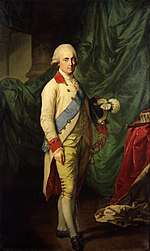
In 1756, during the Third Silesian War between Prussia and Austria (part of the Seven Years' War), Saxony was invaded and overrun by the forces of King Frederick II of Prussia, who took Dresden and after the Siege of Pirna forced the Saxon army to surrender and join his Prussian Army. Many later deserted, and a force of Saxon troops fought to restore their independence. The Treaty of Hubertusburg in 1763 eventually restored Saxony as an entity.
When in 1806 Napoleon began a war with Prussia, Saxony at first allied itself with his long-time rival, but afterwards joined Napoleon and entered the Confederation of the Rhine. Elector Frederick Augustus III (1763–1827) was formally the last Elector of Saxony. With the dissolution of the Holy Roman Empire, he clung to office and became the first monarch of the short-lived Kingdom of Saxony, under the title of Frederick Augustus I of Saxony.
Subdivisions
The Electorate of Saxony was divided into several districts or Kreise (literally "circles", singular Kreis) in the late 15th and renamed in the 19th centuries. These were:
- Electoral Circle, which (roughly) corresponded to the former Duchy of Saxe-Wittenberg, renamed the Wittenberg Circle in 1807
- Erzgebirge Circle, named for the Ore mountains
- Leipzig Circle
- Meissen Circle
- Neustadt Circle, named for Neustadt an der Orla
- Thuringian Circle in northern Thuringia around Weissenfels
- Vogtland Circle in the Vogtland region
Additionally, there were several territories which were not part of Kreise, such as the Margravate of Lusatia.
See also
- Electors of Saxony
- History of Saxony
References
- Based on many original preserved depictions:
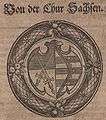 Coat of Arms of Electoral Saxony. In: Theatrum Saxonicum (Volume 1). 1608
Coat of Arms of Electoral Saxony. In: Theatrum Saxonicum (Volume 1). 1608_2006-06-09.jpg) A coat of arms of the Elector of Saxony in Stolpen (Saxony state, Germany), over the entrance to the Electoral Amtshaus.
A coat of arms of the Elector of Saxony in Stolpen (Saxony state, Germany), over the entrance to the Electoral Amtshaus.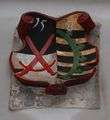 Schwarzenberg Castle, 1558
Schwarzenberg Castle, 1558- Marienberg, 1773
- Based on many original preserved depictions:
 Coat of Arms of Electoral Saxony. In: Theatrum Saxonicum (Volume 1). 1608
Coat of Arms of Electoral Saxony. In: Theatrum Saxonicum (Volume 1). 1608_2006-06-09.jpg) A coat of arms of the Elector of Saxony in Stolpen (Saxony state, Germany), over the entrance to the Electoral Amtshaus.
A coat of arms of the Elector of Saxony in Stolpen (Saxony state, Germany), over the entrance to the Electoral Amtshaus. Schwarzenberg Castle, 1558
Schwarzenberg Castle, 1558- Marienberg, 1773
- Charles IV, Golden Bull of 1356. translated into English, Yale
- Sacher, Hermann (1913). "Electorate of Saxony". In C. Hekbermann; E. Pace; C. Pallen; T. Shahan; J. Wynne; et al. (eds.). The Catholic Encyclopedia. New York: The Encyclopedia Press. pp. 499–501.
- Cordula Bornefeld, "Die Herzöge von Sachsen-Lauenburg", in: Die Fürsten des Landes: Herzöge und Grafen von Schleswig, Holstein und Lauenburg [De slevigske hertuger; German], Carsten Porskrog Rasmussen (ed.) on behalf of the Gesellschaft für Schleswig-Holsteinische Geschichte, Neumünster: Wachholtz, 2008, pp. 373-389. ISBN 978-3-529-02606-5
- Bacon, Paul M. “Art Patronage and Piety in Electoral Saxony: Frederick the Wise Promotes the Veneration of His Patron, St. Bartholomew.” The Sixteenth Century Journal, vol. 39, no. 4, 2008, pp. 973–1001. JSTOR, JSTOR, www.jstor.org/stable/20479134.
- Elizabeth Plummer. "Martin Luther and the Saxon Electors" in Oxford Research Encyclopedias. Subscription necessary for full text. [retrieved 2018.11.27.]
- https://web.archive.org/web/20110719065438/http://www.neumarkt-dresden.de/nikolaus-krell.html (in German)
- Jasienica, Paweł (2007). Rzeczpospolita Obojga Narodów. Dzieje Agonii. Prószynski. pp. 25–27. ISBN 978-83-7469-583-1.
- Kalipke, Andreas (2010). "The Corpus Evangelicorum". In Coy, J.P.; Marschke, B. Benjamin; Sabean D.W. (eds.). The Holy Roman Empire, Reconsidered. Berghahn. pp. 228–247.
- Britannica http://www.britannica.com/EBchecked/topic/526055/Saxony
- Britannica http://www.britannica.com/EBchecked/topic/43134/Augustus-III
Bibliography
Sources in German:
- Reiner Groß: Die Wettiner. Kohlhammer Verlag, Stuttgart 2007, ISBN 978-3-17-018946-1.
- Reiner Groß (Hrsg.): Landtage in Sachsen 1438–1831. Beiträge auf dem von der Professur Regionalgeschichte Sachsens der Technischen Universität Chemnitz veranstalteten wissenschaftlichen Kolloquium am 25. Februar 2000. Technische Universität Chemnitz, Chemnitz 2000.
- Katrin Keller: Kleinstädte in Kursachsen. Wandlungen einer Städtelandschaft zwischen Dreißigjährigem Krieg und Industrialisierung. Böhlau, Köln/Weimar/Wien 2001, ISBN 3-412-11300-X.
- Frank-Lothar Kroll (Hrsg.): Die Herrscher Sachsens. Markgrafen, Kurfürsten, Könige 1089–1918. C.H. Beck, München 2007, ISBN 978-3-406-54773-7.
- Nina Krüger: Landesherr und Landstände in Kursachsen auf den Ständeversammlungen der zweiten Hälfte des 17. Jahrhunderts. Lang, Frankfurt am Main/Berlin/Bern [u. a.] 2007, ISBN 978-3-631-54598-0.
- Hans-Walter Krumwiede: Zur Entstehung des landesherrlichen Kirchenregimentes in Kursachsen und Braunschweig-Wolfenbüttel (= Studien zur Kirchengeschichte Niedersachsens. Band 16). Vandenhoeck und Ruprecht, Göttingen 1967.
- Heinrich Kühne: Die Askanier. Drei Kastanien Verlag, Wittenberg 1999, ISBN 3-933028-14-0.
- Heiner Lück: Die kursächsische Gerichtsverfassung 1423–1550 (= Forschungen zur deutschen Rechtsgeschichte. Band 17). Böhlau, Köln/Weimar/Wien 1997, ISBN 3-412-12296-3.
- Frank Müller: Kursachsen und der böhmische Aufstand 1618–1622. Aschendorff, Münster 1997, ISBN 3-402-05674-7.
- Marcus von Salisch: Treue Deserteure: Das kursächsische Militär und der Siebenjährige Krieg (= Militärgeschichtliche Studien. Band 41). Oldenbourg, München 2008, ISBN 3-486-84852-6.
- Uwe Schirmer: Kursächsische Staatsfinanzen (1456–1656). Strukturen – Verfassung – Funktionseliten (= Quellen und Forschungen zur sächsischen Geschichte. Band 28). Steiner, Stuttgart 2006, ISBN 3-515-08955-1.
Sources in English:
- Hans-Albrecht Koch. Dresden: Crossroads of Europe. Library of Congress https://www.loc.gov/exhibits/dres/dresremb.html [retrieved 2018.11.27]
- Chancellery of Saxony. Coat of arms of Saxony https://www.sachsen.de/en/191.htm [retrieved 2018.11.27]
- Caroline Schelling. trans. Doug Scott (2014). "Germany in the Late 18th Century" https://www.carolineschelling.com/appendices/volume-1/sup-ap-germany-late-18th-century/


